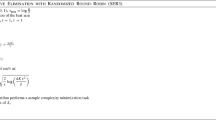Abstract
In the stochastic multi-armed bandit problem we consider a modification of the UCB algorithm of Auer et al. [4]. For this modified algorithm we give an improved bound on the regret with respect to the optimal reward. While for the original UCB algorithm the regret in K-armed bandits after T trials is bounded by const · \( \frac{{K\log (T)}} {\Delta } \), where Δ measures the distance between a suboptimal arm and the optimal arm, for the modified UCB algorithm we show an upper bound on the regret of const · \( \frac{{K\log (T\Delta ^2 )}} {\Delta } \).
Similar content being viewed by others
References
Rajeev Agrawal, Sample mean based index policies with O(log n) regret for the multi-armed bandit problem, Adv. in Appl. Probab., 27 (1995), 1054–1078.
Jean-Yves Audibert and Sébastien Bubeck, Minimax policies for adversarial and stochastic bandits, Proceedings of the 22nd Annual Conference on Learning Theory (COLT2009), 2009, 217–226.
Jean-Yves Audibert, Rémi Munos and Csaba Szepesvári, Exploration-exploitation tradeoff using variance estimates in multi-armed bandits, Theor. Comput. Sci., 410 (2009), 1876–1902.
Peter Auer, Nicolò Cesa-Bianchi and Paul Fischer, Finite-Time Analysis of the Multi-Armed Bandit Problem, Mach. Learn., 47 (2002), 235–256.
Peter Auer, Nicolò Cesa-Bianchi, Yoav Freund and Robert E. Schapire, The Nonstochastic Multiarmed Bandit Problem, SIAM J. Comput., 32 (2002), 48–77.
Eyal Even-Dar, Shie Mannor and Yishay Mansour, Action Elimination and Stopping Conditions for the Multi-Armed Bandit and Reinforcement Learning Problems, J. Mach. Learn. Res., 7 (2006), 1079–1105.
Wassily Hoeffding, Probability inequalities for sums of bounded random variables, J. Amer. Statist. Assoc., 58 (1963), 13–30.
Robert D. Kleinberg, Nearly Tight Bounds for the Continuum-Armed Bandit Problem, Advances in Neural Information Processing Systems 17, MIT Press, 2005, 697–704.
Tze Leung Lai and Herbert Robbins, Asymptotically Efficient Adaptive Allocation Rules, Adv. in Appl. Math., 6 (1985), 4–22.
Shie Mannor and John N. Tsitsiklis, The Sample Complexity of Exploration in the Multi-Armed Bandit Problem, J. Mach. Learn. Res., 5 (2004), 623–648.
Richard S. Sutton and Andrew G. Barto, Reinforcement Learning: An Introduction, MIT Press, 1998.
Author information
Authors and Affiliations
Corresponding author
Additional information
Dedicated to Endre Csáki and Pál Révész on the occasion of their 75th birthdays
Rights and permissions
About this article
Cite this article
Auer, P., Ortner, R. UCB revisited: Improved regret bounds for the stochastic multi-armed bandit problem. Period Math Hung 61, 55–65 (2010). https://doi.org/10.1007/s10998-010-3055-6
Received:
Accepted:
Published:
Issue Date:
DOI: https://doi.org/10.1007/s10998-010-3055-6




